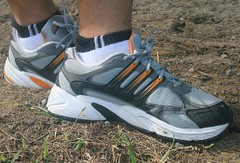skip to main |
skip to sidebar
TEMPERATURE REGULATION
INCREASE IN BODY TEMPERATURE
- An increase in body temperature, for example due to vigorous exercise or being in a warm place, causes the blood and the skin temperature to increase (stimulus).
- The temperature receptors in the skin detect this increase.
- A signal in the form of nerve impulse is then transmitted to the hypothalamus in the brain.
- When the hypothalamus is stimulated, it then transmits nerve impulses to the relevant body parts.
- The arterioles in the skin dilate. More blood is transported to the blood capillaries and this removes more heat.
- Sweat glands become active and more sweating occurs and hence more heat removed.
- The hair erector muscles in the skin relax causing the hair to lie flat. Therefore less heat is trapped by the hair.
- Metabolic rate decreases and hence heat production decreases.
- Breathing rate increases so as to remove more heat in exhaled air.
- All these mechanisms lower down the blood temperature (Negative feedback) and eventually the temperature will return to normal.
DECREASE IN BODY TEMPERATURE
- A decrease in body temperature, for example due to starvation, fasting or being in cold places, causes the blood and the skin temperature to decrease (stimulus).
- The temperature receptors in the skin detect this decrease.
- A signal in the form of nerve impulse is then transmitted to the hypothalamus in the brain.
- When the hypothalamus is stimulated, it then transmits nerve impulses to the relevant body parts.
- The arterioles in the skin constrict. Less blood is transported to the blood capillaries and hence less heat is removed.
- Sweat glands become inactive and no sweating occurs. Therefore no heat is removed.
- The hair erector muscles in the skin contract causing the hair to stand erect. Therefore more heat is trapped by the hair. (Remember: still air trapped in between the hairs acts as an insulator, therefore less heat is removed)
- Metabolic rate increases and hence heat production increases.
- Breathing rate decreases so as to conserve more heat.
- Shivering due to muscle contractions occurs if very cold to produce more heat.
- All these mechanisms increases the blood temperature (Negative feedback) and eventually the temperature will return to normal.
